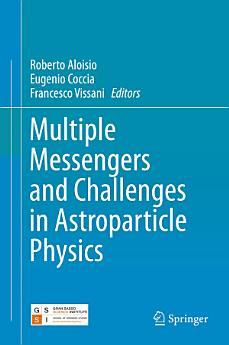Multiple Messengers and Challenges in Astroparticle Physics
Roberto Aloisio · Eugenio Coccia · Francesco Vissani
Feb 2018 · Springer
eBook
552
Halaman
reportRating dan ulasan tidak diverifikasi Pelajari Lebih Lanjut
Tentang eBook ini
This book, designed as a tool for young researchers and graduate students, reviews the main open problems and research lines in various fields of astroparticle physics: cosmic rays, gamma rays, neutrinos, cosmology, and gravitational physics. The opening section discusses cosmic rays of both galactic and extragalactic origin, examining experimental results, theoretical models, and possible future developments. The basics of gamma-ray astronomy are then described, including the detection methods and techniques. Galactic and extragalactic aspects of the field are addressed in the light of recent discoveries with space-borne and ground-based detectors. The review of neutrinos outlines the status of the investigations of neutrino radiation and brings together relevant formulae, estimations, and background information. Three complementary issues in cosmology are examined: observable predictions of inflation in the early universe, effects of dark energy/modified gravity in the large-scale structure of the universe, and neutrinos in cosmology and large-scale structures. The closing section on gravitational physics reviews issues relating to quantum gravity, atomic precision tests, space-based experiments, the strong field regime, gravitational waves, multi-messengers, and alternative theories of gravity.
Tentang pengarang
Roberto Aloisio is a Professor at the Gran Sasso Science Institute, L'Aquila, Italy. His research is concentrated on studies at the boundaries between particle physics and astrophysics. His interests include the origin and propagation of cosmic rays, the possible indirect detection of dark matter, and, generally, nonthermal processes in astrophysics. He has also worked on theories with broken Lorentz invariance. Dr. Aloisio is involved in the activities of the High-Energy Astrophysics Group at the Arcetri Astrophysical Observatory and the Theory Group at the Gran Sasso National Laboratories.
Eugenio Coccia is Director of the Gran Sasso Science Institute and Professor of Physics at the University of Rome Tor Vergata, Italy. He is an experimental physicist with a focus on the detection of gravitational waves and an interest in neutrino physics and cosmic ray detectors. He has directed the EXPLORER experiment at CERN and leads the NAUTILUS experiment at the INFN Frascati Laboratories. He has been Director of the INFN Gran Sasso Laboratory (2003–2009), President of the Italian Society of General Relativity and Gravitational Physics (2000–2004), and Chair of the INFN Scientific Committee on Astroparticle Physics (2002–2003). He is currently the Chair of the Gravitational Wave International Committee (GWIC) and a member of the Council of the European Physical Society. In 2012 he was awarded the "Occhialini Medal" and Prize by the Institute of Physics (IOP), jointly with the Italian Physical Society.
Francesco Vissani earned a PhD in high-energy physics from SISSA in 1994 and is currently a Professor at the Gran Sasso Science Institute, L'Aquila, Italy. His interests focus on astrophysics, and in particular supernova neutrinos; very high energy neutrinos and gamma rays; connections between particle physics and astrophysics; cosmic rays; lepto/baryogenesis; manifestations of neutrino masses; flavor oscillations; other probes of neutrino masses; tests ofthe lepton/baryon numbers and of CP violation; and extensions of the standard model. In 2008 he received the Occhialini Award for his research in neutrino physics.
Eugenio Coccia is Director of the Gran Sasso Science Institute and Professor of Physics at the University of Rome Tor Vergata, Italy. He is an experimental physicist with a focus on the detection of gravitational waves and an interest in neutrino physics and cosmic ray detectors. He has directed the EXPLORER experiment at CERN and leads the NAUTILUS experiment at the INFN Frascati Laboratories. He has been Director of the INFN Gran Sasso Laboratory (2003–2009), President of the Italian Society of General Relativity and Gravitational Physics (2000–2004), and Chair of the INFN Scientific Committee on Astroparticle Physics (2002–2003). He is currently the Chair of the Gravitational Wave International Committee (GWIC) and a member of the Council of the European Physical Society. In 2012 he was awarded the "Occhialini Medal" and Prize by the Institute of Physics (IOP), jointly with the Italian Physical Society.
Francesco Vissani earned a PhD in high-energy physics from SISSA in 1994 and is currently a Professor at the Gran Sasso Science Institute, L'Aquila, Italy. His interests focus on astrophysics, and in particular supernova neutrinos; very high energy neutrinos and gamma rays; connections between particle physics and astrophysics; cosmic rays; lepto/baryogenesis; manifestations of neutrino masses; flavor oscillations; other probes of neutrino masses; tests ofthe lepton/baryon numbers and of CP violation; and extensions of the standard model. In 2008 he received the Occhialini Award for his research in neutrino physics.
Beri rating eBook ini
Sampaikan pendapat Anda.
Informasi bacaan
Smartphone dan tablet
Instal aplikasi Google Play Buku untuk Android dan iPad/iPhone. Aplikasi akan disinkronkan secara otomatis dengan akun Anda dan dapat diakses secara online maupun offline di mana saja.
Laptop dan komputer
Anda dapat mendengarkan buku audio yang dibeli di Google Play menggunakan browser web komputer.
eReader dan perangkat lainnya
Untuk membaca di perangkat e-ink seperti Kobo eReaders, Anda perlu mendownload file dan mentransfernya ke perangkat Anda. Ikuti petunjuk Pusat bantuan yang mendetail untuk mentransfer file ke eReaders yang didukung.





